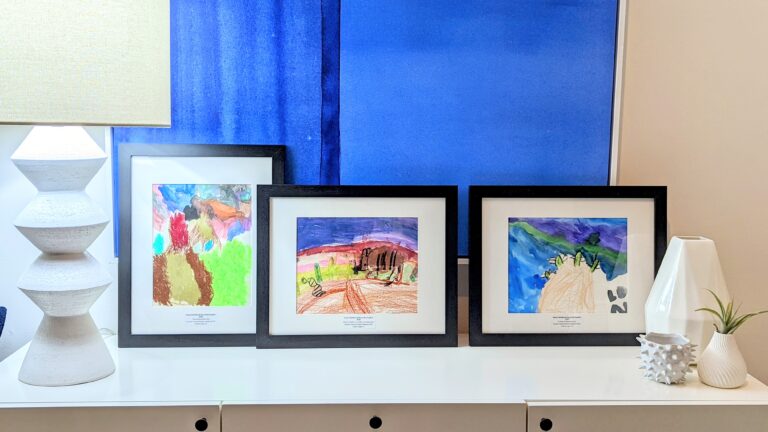Preschool Art at the Capitol
Making Children and Early Childhood Educators Visible in the Community
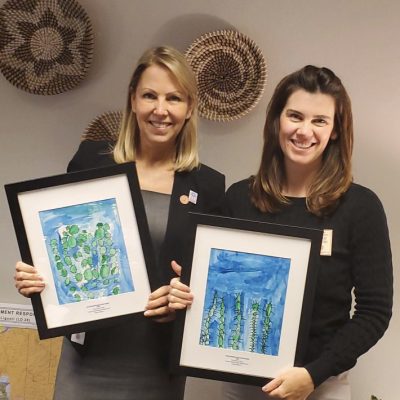
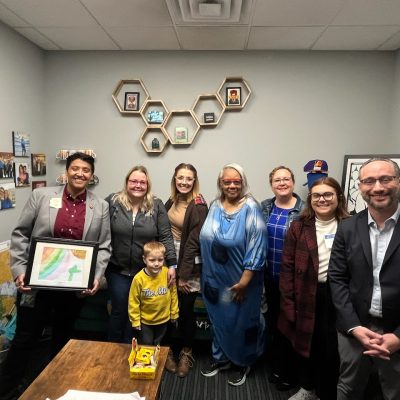
In our AzAEYC “Preschool Artwork at the Capitol” signature initiative, we collect children’s beautiful artwork from local child care providers, frame and mat the pieces, and deliver them to elected officials to highlight the importance of supporting early care and education (ECE). Our goal is to make children’s capabilities as lifelong learners more visible, highlight child care issues, and lift up the essential work of early childhood educators.
First started in 2021 as part of the annual early childhood day at the state legislature, AzAEYC’s “Preschool Artwork at the Capitol” has worked with 20 Arizona ECE programs to deliver 90 pieces of young children’s artwork to state lawmakers, congressional representatives, community leaders, and even the Governor’s office.
We invite Arizona ECE programs and child care providers to be a part of this important project! We collect children’s artwork throughout the calendar year for early childhood advocacy efforts such as meeting with lawmakers to discuss investments in child care and also for the AzAEYC website, social media, and publications as part of our commitment to using photos and artwork from real Arizona children.
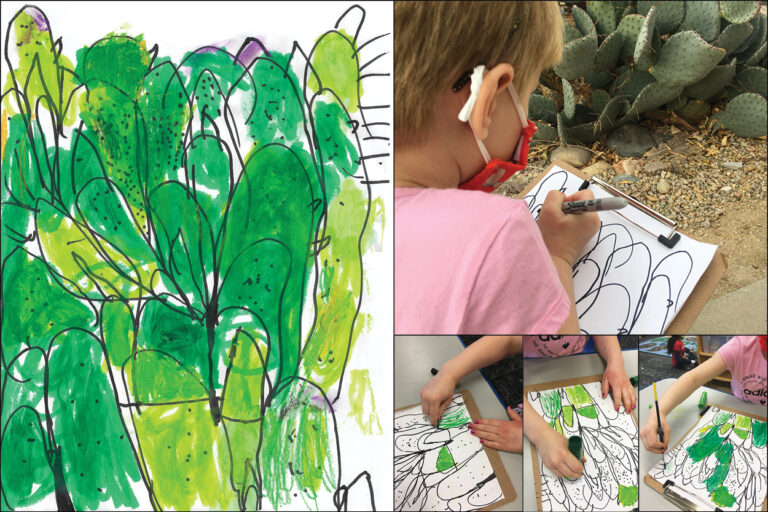
Steps:
- Consider inviting children to study images or books of the Arizona desert, or look out the window or on the playground. You might also plan a neighborhood walk with the children to find, take pictures of, and sketch the cacti, animals, and other “desert dwellers” you see.
- Offer quality art materials such as watercolor paint, markers, crayons, or oil pastels along with paper to a small group of children (any age between 3 and 5 years old). If you’re offering paint, be sure to use a thicker paper made for painting.
- Invite the children to draw, paint, color, and represent their observations of the Arizona desert which may include a full landscape painting, a detailed cactus, a detailed animal, and any other ideas children have about nature and the outdoors.
- Once the children have completed their artwork, write the child’s age, name of your child care program, and the teacher’s name on the BACK of the paper (not on the front) or attach a sticky note to the artwork with the requested information.
- Carefully package a stack of 5-6 pieces of artwork in a self-stamped, appropriate-sized envelope, and mail them to the following address:
AzAEYC, PO Box 15233, Phoenix, AZ 85060
You can also email us to see if we are able to come pick up the pieces directly from your program: info@azaeyc.org.
- Email us at info@azaeyc.org to let us know the artwork is in the mail. AzAEYC will track the pieces to let you know where in the Capitol or in the community children’s beautiful artwork is being displayed! For each framed artwork, we reference the child’s age (not their name) and the current year and credit the teacher/program.
What we’re looking for:
- Artwork from preschool-age children 3 through 5 years old in Arizona ECE programs.
- Artwork that is 8.5″ x 11″ or smaller to fit within an 8.5″ x 11″ frame.
- Flat artwork and 2-dimensional materials that can fit under a glass in a frame.
- Artwork around a variety of topics such an things in nature, the Arizona desert landscape, cacti and desert plants or flowers, pine trees, mountains, desert animals, or other representations of the child care program’s community and context.
- Child-made artwork (nothing with teacher-made materials).
Examples of previous artwork:
What we’re not looking for:
Artwork from children under age 3 or older than age 5.
Artwork with scribbles or simple shapes and lines. While we recognize all young children’s artwork is beautiful and children’s marks indicate their ideas and theories about the world, we are looking for specific themes for this project.
Teacher-made projects, dittos, or copies. (We want to see children’s abilities and ideas.)
Questions or need support? Email us at info@azaeyc.org.
Want ideas for what materials to offer? Check out the tab below.
Need materials to get started? Packages of quality, developmentally-appropriate art materials (e.g., oil pastels, watercolor paint, paint brushes, and watercolor paper) may be available to early childhood teachers that need them. Rural child care programs, programs not enrolled in Quality First, and non-Head Start programs will be prioritized. Supply is limited. Email info@azaeyc.org to request a package of art materials.
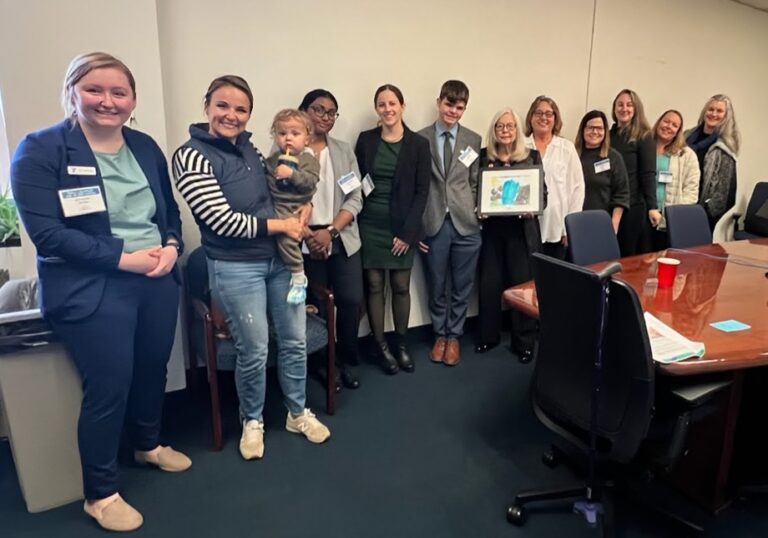
- Oil pastels and pastel paper (teachers have suggested Sakura Cray-Pas Junior Artist Oil Pastel Sets and Clairefontaine Pastelmat Pads)
- Watercolor and watercolor paper (teachers have suggested Prang square Watercolor Pans with 16 colors or Blick Broadline watercolor markers and watercolor paper with Sharpie fine point markers to sketch the outlines)
- Tempera paint and painting paper (teachers have suggested Blick Student Grade Tempera Paints or Richeson Tempera Cakes)
- Markers, colored Sharpies, and cardstock paper
Project Cactus: Celebrate Young Learners!
In this article featured in Raising Arizona Kids magazine, teacher Marjorie Ruiz takes preschoolers on a nature walk and encourages their research of the Arizona desert. This experience shows that children are complex thinkers and capable learners, with a right to interact and build relationships with one another, explore quality materials, and be heard by their adults. The artwork from Marjorie’s project was part of the 2021 Arizona Early Childhood Day at the Capitol.
A Partnership with Nature: An Urban School’s Collaborative Study
In this article from NAREA Innovations, Authors Kristin Brizzolara Vazquez and Dr. Karen Haigh share experiences from Velma Thomas Early Childhood Center, a Chicago Public School Child-Parent Center. Teachers from seven classrooms, along with Veronica Cline, parent educator, share individual stories from a nature-focused classroom study in which children explored nature and represented it through varying art media including paint.
What Will We Make? Using Process Art to Spark Preschoolers’ Development
This article in NAEYC’s Teaching Young Children from teacher Loretta Fernando-Smith describes how process art experiences enhance children’s expression, social-emotional development, and collaboration and shares suggestions for introducing materials to children including questions to ask and recommended materials and tools.
The Oil Pastels Study: Children’s Right to Quality Art Materials
Children deserve more than just the typical markers and crayons most programs offer. In this study, teacher Miranda Brown and director Katy Moon offered children oil pastels to explore. What unfolded was an 8-month long exploration of children’s mark-making, during which the preschool teachers offered various materials to children, and then studied how they used them. Children preferred the oil pastels because of their potential to help them represent their ideas and create the outcome they desired.

